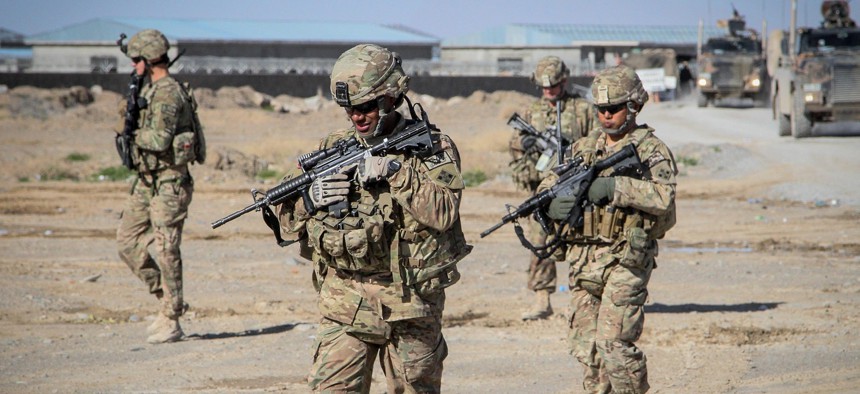
U.S. Soldiers with Forward Support Company, 65th Engineer Battalion conduct a presence patrol March 26, 2014, in Kandahar province, Afghanistan. DoD photo by Cpl. Clay Beyersdorfer
How Many US Troops in Afghanistan? Pentagon Changes How It Counts Them
A new accounting method ups the official total in Afghanistan from 8,400 to “approximately” 11,000.
If you’d asked Pentagon officials on Wednesday morning, “How many U.S. troops are deployed to Afghanistan?” they’d have told you “about 8,400.” If you ask them now, they’ll tell you “approximately 11,000” — maybe a thousand troops less than the actual best estimate.
It’s not the deployed force that changed, but rather the Pentagon’s method of calculating and reporting its size. In the wake of President Trump’s recent decision to add troops to the counterinsurgency and advise-and-assist efforts in Afghanistan, Defense Secretary James Mattis decided to shift to a more straightforward way of reporting the numbers there and in Iraq, according to Dana White, the Pentagon’s new top spokeswoman.
Previously, U.S. officials had used an ambiguous metric called “force management level,” which was often thousands of troops lower than the actual numbers deployed. That was an attempt to rotate various units into the war zone and yet keep the total number of troops below caps set by the Obama administration and retained for seven months by the Trump White House.
“Often commanders were compelled to reduce the sizes of deploying units in order to meet theater force management levels and limit the time that units could remain in operational theaters,” White said.
Pentagon spokesman Eric Pahon gave an example. An Army combat aviation brigade of 3,000 might leave its maintenance troops home, and once in-country, outsource the work to contractors, who do not count against force caps. This siphoned money from the Army, led to subpar maintenance, and hurt the morale of the troops left behind, Pahon said.
White said, “This way of doing business is over.”
From now on, said Marine Corps Lt. Gen. Frank McKenzie, director of the Joint Staff at the Pentagon, “We will characterize all forces necessary for the steady-state missions of train, advise, assist and counterterrorism as total forces.”
“Included in total forces in Afghanistan will be the troops required for short-duration missions, which vary based upon operational conditions, but are not needed for the duration of the operation,” he said. “This includes troops in a temporary duty status, troops assigned to combat support agencies and forces assigned to the material recovery element and the Resolute Support sustainment brigade.”
But don’t expect that total number to be exactly on the nose.
“One of the things we want to do here is avoid the ability to draw sand charts and graphs on this to give direct information to the enemy and sort of preclude telegraphing things that we want to do,” McKenzie said. “We believe it’s not in our interest to actually parse this out in great detail, which is why we’re adopting a single number.”
As for Iraq, Pentagon officials aren’t quite ready to move to the new reporting system. White declined to provide a revised troop number, citing an ongoing review.




